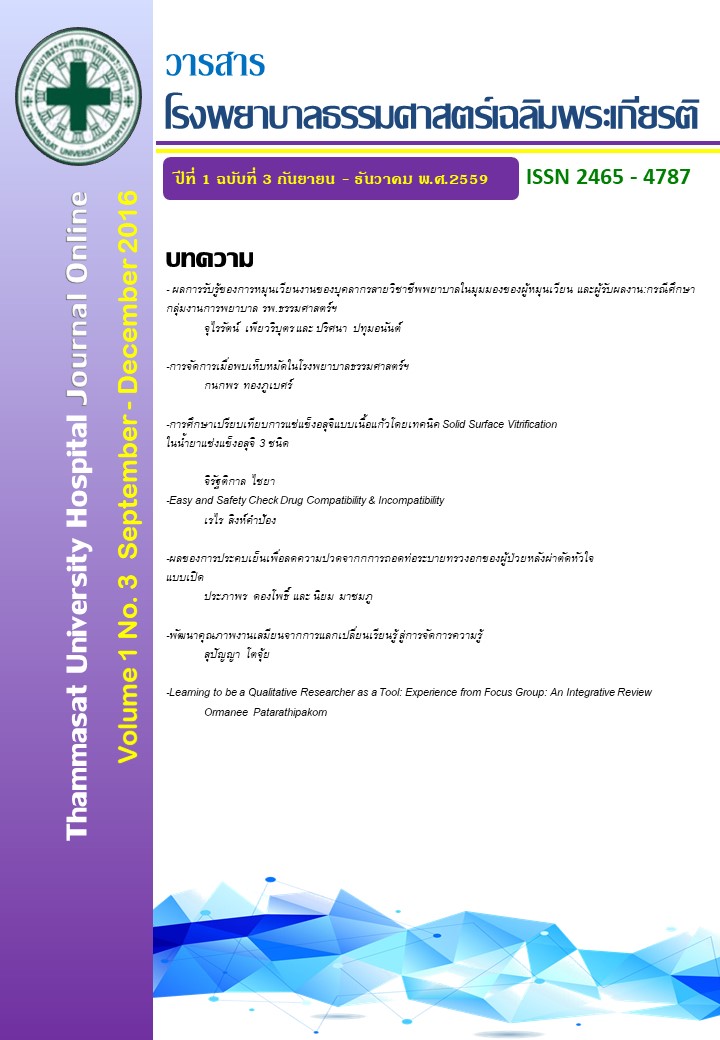ผลการรับรู้ของการหมุนเวียนงานของบุคลากรสายวิชาชีพพยาบาลในมุมมองของผู้หมุนเวียน และผู้รับผลงาน: กรณีศึกษา กลุ่มงานการพยาบาล รพ.ธรรมศาสตร์เฉลิมพระเกียรติ
Keywords:
Job Rotation, Nursing Staff, Rotated Nurses, StakeholdersAbstract
The purpose of this research was to study the result of job rotation perception of nursing staff in perspective of rotated nurses and stakeholders in nursing department, Thammasat university hospital (TUH). The samples were 11 rotated registered nurses, stakeholders included 5 nurse supervisors and 148 nursing staffs who were under those rotated nurses. The instrument was the questionnaire modified from Dusadee Yola and et. al. (2003). Data were analyzed by descriptive statistics such as mean, percentage and standard deviation.
The findings were as follows: the perception of rotated nurses were including increased knowledge and experiences at a high level, average 4.09 and 4.09 respectively, getting to know more new colleagues at the highest level, average 4.36, increased self-development at average 4.09, and be accepted increasingly by colleagues at a high level, average 3.64. The perception of supervisors were including the rotated nurses increased their experiences at the highest level, average 4.40, coordinated with others more speediness at a high level, average 3.60, be alert and enthusiasm at a high level, average 3.60 whereas they had problem of adaptation such as stress and anxiety as well. And the perception of subordinate staff were including the rotated nurses had work hard at high level, average 3.97, coordinated with other staff with speediness at a high level, average 3.76, and be alert with enthusiasm increasingly at a high level, average 3.84.
The study propositions pointed that the job rotation should be begun with policy, goals, time frame clearly. Additions, the preparation of practices, knowledge should be done before rotation, and psychological support should be prepared for the rotated nurses as well, to reduce their stress and anxiety which can impact to their physical and mind.
References
กระแสโลก กระแสโลก. (2551). เรียนรู้ระบบราชการญี่ปุ่น: มองผ่านกรอบแนวคิดของข้าราชการไทย (ออนไลน์). มติชนรายสัปดาห์, ค้นหาวันที่ 5 มีนาคม 2559. จาก website: https://info.matichon.co.th/weekly/
จิรศักดิ์ โพกาวิน. (2551). การหมุนเวียนงาน (Job Rotation) ทางเลือกหนึ่งสำหรับการพัฒนาทรัพยากรมนุษย์ (ออนไลน์), ค้นหาวันที่ 5 มีนาคม 2559. จาก website: https://www4.msu. ac.th/politics/book6y/2/2/5.pdf.
ดุษฏี โยเหลา และคณะ. (2546). การศึกษา
ผลกระทบของการหมุนเวียนผู้บริหารระดับกลางของมหาวิทยาลัยศรีนครินทรวิโรฒ. รายงานการวิจัย ฉบับที่ 89, มหาวิทยาลัยศรีนครินทรวิโรฒ.
รัตติยา ปริชญากร. (2556). ทัศนคติต่อการนำระบบการหมุนเวียนงาน (Job Rotation) มาใช้กับเจ้าหน้าที่ในสายงานเดียวกัน: กรณีศึกษาผู้ปฏิบัติงานในหน่วยงานของคณะแพทยศาสตร์ มหาวิทยาลัยสงขลานครินทร์. วารสารวิชาการคณะมนุษยศาสตร์และสังคมศาสตร์, 9 (1), 41 – 56.
ศิริพร แก้วแพรก. (2549). การพัฒนาทรัพยากรมนุษย์ในเชิงธุรกิจ. วารสารการพัฒนาทรัพยากรมนุษย์, 2(2), 241 – 249.
สัมฤทธิ์ ยศสมศักดิ์. (2548). หลักรัฐประศาสนศาสตร์แนวคิดและทฤษฎี. กรุงเทพฯ:รัตนพรชัย การพิมพ์.
อรวรรณ บิลันธน์โอวาท. (2554). การสื่อสารเพื่อโน้มน้าวใจ. กรุงเทพฯ: จุฬาลงกรณ์มหาวิทยาลัย.
Graham Lowe. (2008). Energize & Enhance Employee Value with Job Rotation, ค้นหาวันที่ 5 มีนาคม2559. จาก website: https://yellowedge.files.wordpress.com/2008/06/jobrotation.pdf.
jobjob. (2551). ชาร์จแบตฯพนักงานด้วย Job Rotation, ค้นหาวันที่ 5 มีนาคม 2559. จาก website: https://www.jobjob.co.th/th/HR-Variety/ 564.



